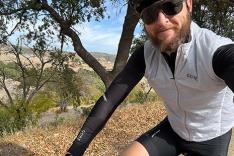Poorly Applied Indoor Training
I once read a newspaper article about a man who was training to race up Mount Washington by going into his local gym and riding the Spinner? bike for hours on end. This was his first time doing this event, and one of his training "techniques" was to take the saddle away from the indoor bike, forcing him to ride standing up for an hour or more, and pedal at high resistance and a low cadence. The article had a photo of him standing up, the seat post lying on the floor beside the bike as he grimaced to turn the pedals.
I don't know if he ever made it up Mount Washington (one of the hardest hill climbs in the world) but if he did it was in spite of his stupid training methods. Forgive me for my bluntness, but sometimes you just have to say it like it is.
There is nothing smart about what he was doing. The risk for injury was very high and it had very little application to what he was supposedly training for. First of all you do not stand up on Mount Washington for an hour if you hope to make it up in one piece. Second, you would install gearing similar to what Alberto Contador used in the Giro d'Italia, that allows you to pedal at a reasonable cadence that won't grind out your knees. Third, you would train in the way that would most closely mimic the riding position, gearing (resistance), cadence, and intensity that you would use or attain in the event. Fourth, if you were smart, you'd hire a coach who knew what she was doing.
The Takeaway
If you take an indoor cycling class and you are not an elite cyclist, then you should stick to the prescribed cadences that most reputable indoor cycling certifications recommend: somewhere between 60 and 110 rpm (some say 55 on the low end, or up to 120 for skilled students on the high end). Very strong and skilled cyclists might have reasons to venture a little above 110 rpm or below 60 rpm for short periods, but the exceptions are few and far between.
As outlined in this article, the reasons for those ranges are effectiveness, cycling specificity and maximum performance improvement with the least potential for injury. Whether you are a cyclist or not, whenever you take a Spinning? or indoor cycling class, the number one most important goal should be to keep it real.
And by the way, if your instructor ever asks you to take away the saddle, because he says it will make you "stronger", whether you are a cyclist or not, run--don't walk--to the nearest door!
More: 6 Reasons to Join an Indoor Cycling Class
 Ready to ride? Search for a cycling event.
Ready to ride? Search for a cycling event.- 3
- of
- 3
About the Author









Discuss This Article